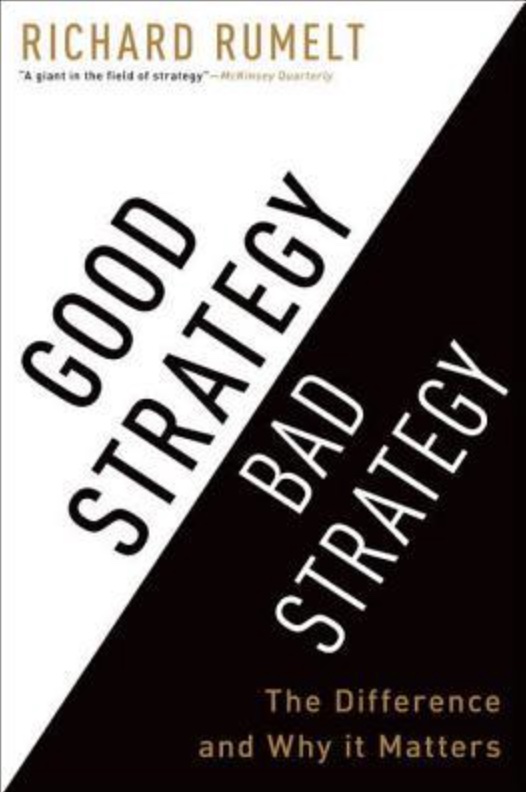Key Quote:
“A good strategy does more than urge us forward toward a goal or vision. A good strategy honestly acknowledges the challenges being faced and provides an approach to overcoming them” (p. 4). — Richard P. Rumelt
Key Points
Bad strategy is evidenced by four hallmarks: “fluff” (an abundance of words that provide no real insight or direction), “failure to face the problem,” “mistaking goals for strategy,” and missing the forest for the trees by neglecting general goals in the service of low-level to-do lists.
Good strategy must include an accurate diagnosis of the challenge being faced, a guiding policy as to how to approach the challenge, and coherent actions to implement the guiding policy.
Leverage. Leaders use certain tactics to achieve goals. These are tactics like choosing realistic objectives, ensuring every aspect of the system is functioning well, making sure each part of a system is working together towards the goal, measuring strengths and weaknesses straightforwardly to stay competitive, staying abreast or ahead of changes happening in an industry, and more. Think like a strategist by honing your own internal “process of creation and testing” (p. 238). Rumelt suggests developing and practicing techniques to help you honestly and effectively critique your own ideas and remain focused on the challenge and solutions to it.
Key Concepts:
Good and Bad Strategy
Bad strategy is more than the absence of a good strategy. Bad strategy encapsulates leadership dysfunction and stems from a series of vague statements. There are four major hallmarks of identifying a bad strategy or lack thereof. Once we master recognizing bad strategies, the ability to create good strategy will come with ease. (p. 31). “All too much of what is put forward as strategy is not. The basic problem is confusion between strategy and strategic goals” (p. 34).
The Four Hallmarks of Bad Strategy
“Fluff” (p. 37). Described as buzzwords, gibberish, and clichés, fluff is padding in the world of strategy. Fluff “masquerades as expertise, thought, and analysis” but never really adds to a substantive strategy (p. 37). Rumelt’s largest fault with fluff is that it parades as something elevated rather than providing any real tangible direction.
“Failure to face the problem” (p. 41). This failure stems from the inability of recognizing or defining the challenge at hand. If a problem is not defined, it is impossible to create a good strategy to address it. When an organization fails to confront and define the obstacle it faces, the result is a lack of strategic thinking. “If you fail to identify and analyze the obstacles, you don’t have a strategy. Instead, you have either a stretch goal, a budget, or a list of things you wish would happen” (p. 42).
“Mistaking goals for strategy” (p. 45). Many statements claimed as strategies are instead, statements of desire. These goals can include statements like being the firm of choice, revenue growth, and creating a positive company culture. Although these are important goals, Rumelt emphasizes these are not strategies.
A good strategy requires more than wanting a positive change or envisioning success, and organizations should ask themselves, “what actually has to happen?” Motivation cannot be the only driver in positive strategy building. Rumelt explains that “business competition is not just a battle of strength and wills; it is also a competition over insights and competencies” (p. 50). He continues, “leaders must identify the critical obstacles to forward progress and then develop a coherent approach to overcoming them. This may require product innovation, or new approaches to distribution, or a change in organizational structure” (p. 51).
“Bad strategic objectives” (p. 51). When a leader fails to address a critical issue, they have also failed to put in place a sound strategic objective. This becomes an example of a bad strategy when one focuses on targeting specific rather than general goals.
Rumelt argues that sub-goals that stem from general goals are the most important when establishing larger strategic objectives – and by extension good strategy. Described as “dog’s dinner” or a “blue-sky objective,” this hallmark challenges the notion of mislabeled objectives.
“A long list of ‘things to do,’ often mislabeled as ‘strategies’ or ‘objectives,’ is not a strategy” (p. 53). “Good strategy works by focusing energy and resources on one, or a very few, pivotal objectives whose accomplishment will lead to a cascade of favorable outcomes” (pp. 50-56).
Prevalence of Bad Strategy
Bad strategy is born from the unwillingness or inability to deliver meaningful change. The most difficult part of creating a good strategy is the choice itself (p. 60).
“When leaders are unwilling or unable to make choices among competing values and parties, bad strategy is the consequence” (p. 58).
Bad strategy blurs the definition of a leader and the definition of good strategy. One example of this is a “template-style strategy.” The template-style strategy includes the sub-topics: vision, mission, set of values, and designated strategies. Rumelt states these “strategies” are just a restatement of an organization’s goals.
This approach aims to present strategy in a positive light rather than confront the choices at hand. “Template-style strategy frees them from the onerous work of analyzing the true challenges and opportunities faced by the client” (p. 68). Strategy is more than a broad restatement of the company’s mission and vision.
The Kernel of Good Strategy
Good strategy contains three elements:
1. “A diagnosis” (p. 77). This is the ability to identify and comprehend the current challenge impacting an organization. Understanding the most critical aspect of a challenge or situation is the initial step in creating a comprehensive strategy. “A great deal of strategy work is trying to figure out what is going on. Not just deciding what to do, but the more fundamental problem of comprehending the situation” (p. 79).
2. “A guiding policy” (p. 77). Similar to how a diagnosis identifies a problem, the guiding policy outlines how to approach the problem. The guiding policy includes the method and specific actions used to address a particular challenge. “Good strategy is not just ‘what’ you are trying to do. It is also ‘why’ and ‘how’ you are doing it. A good guiding policy tackles the obstacles identified in the diagnosis by creating or drawing upon sources of advantage” (p. 84).
3. “A set of coherent actions” (p. 77). Coherent action is action connected with guiding policy. It is the actions that must happen for a specific guiding policy to occur. Through a clearly defined challenge, it is much easier to coordinate direct action. “The coordination of action provides the most basic source of leverage or advantage available in strategy” (p. 90).
Sources of Power
Leverage is the ability to predict the behavior of others and use the insight to focus on a critical or pivotal situation. Concentration involves honing on the specific situation and applying a “level of effort necessary to affect the system” (p. 102).
“Proximate objectives.” These identify a goal or objective that an organization can reasonably achieve. This does not mean the goal has to be simple, rather it only needs to be feasible. For example, Rumelt considers President Kennedy’s call to place a man on the moon in the 1960s a proximate objective. The United States had the technology for a moon landing, but this proximate objective provided the needed political will (p. 106).
“Chain-link systems.” A chain-link system occurs when parts of the chain are dependent on one another to function. If one aspect of the chain fails to function, the entire chain-link system is at risk of collapse. In a business context, Rumelt states it is imperative to strengthen the entire chain-link system rather than a single unit. “A system has a chain-link logic when its performance is limited by its weakest subunit, or ‘link’” (p. 116).
“Design.” Similar to guiding policy, design ensures all parts of a system are working in the interest of the whole. Rumelt explains “a good strategy coordinates policies across activities to focus the competitive punch” (p. 131).
“Growth.” Growth itself is not a strategy, rather it is the result of a good strategy. According to Rumelt, growth is the reward for innovation, creativity, and efficiency. “It is the outcome of growing demand for special capabilities or of expanded or extended capabilities. It is the outcome of a firm having superior products and skills” (p. 159).
“Competitive advantage.” This is the practice of measuring an organization’s strengths and weaknesses. Once an organization identifies its strength or particular advantage, the next step is to continue deepening and extending its competitive advantage. This tactic will not only add value to buyers or clients but the company itself. “You must press where you have advantages and side-step situations in which you do not. You must exploit your rivals’ weaknesses and avoid leading with your own” (p. 160).
“Using dynamics.” This approach centers around the idea of predicting and navigating change. Even in stable industries, change is bound to occur. To maintain success, it is a good strategy to understand the reason and underlying impact of the change. Rumelt lists “guideposts” that can signal the beginning of industry change or transition. These are “escalating fixed costs,” “deregulation,” “predictable biases in forecasting,” “incumbent response to change,” and the “concept of an attractor state” – a sense of how the industry should work (p. 193).
“Entropy.” Entropy has the potential to bring down and slow down the previous success of a company. Rumelt refers to it as “weeds in the garden,” and entropy involves the continued maintenance of an organization’s strategy. Like a garden, Rumelt emphasizes good strategy necessitates “management – just undoing the accumulated clutter and waste from years of entropy at work” (p. 216).
The Science of Strategy
Rumelt compares strategy to a science experiment. “A new strategy is, in the language of science, a hypothesis, and its implementation is an experiment.” Good strategy is a series of trial-and-error and there is no guarantee one strategy will be successful over the other (p. 241).
“Treating strategy like a problem in deduction assumes that anything worth knowing is already known – that only computation is required” (p. 243).
Knowledge is important in strategy creation, but it is not the most critical thing. Rumelt argues it is more important to cultivate the skills that design good strategy. There are three essential skills or techniques that coincide with good strategy creation. The “kernel of good strategy” and its elements, the “problem-solution approach,” and the “create-destroy” tactic.
Kernel: Keep in mind those three basics (discussed earlier) of the beginnings of a good strategy – diagnosis, guiding policy, and coherent action (p. 268).
Problem-solution: Keep in mind that changes in a situation require you regularly identify obstacles and regularly “shift your attention from what is being done to why it is being done” (p. 270).
Create-destroy tactic: Be willing to brutally poke holes in your own strategy, assessing any weakness so that you may address it.
“Good strategy grows out of an independent and careful assessment of the situation, harnessing individual insight to carefully crafted purpose. Bad strategy follows the crowd, substituting popular slogans for insights” (p. 275).
Rumelt, R.P. (2011.) Good Strategy Bad Strategy: The Difference and Why it Matters. New York: Penguin Random House.

“A good strategy does more than urge us forward toward a goal or vision. A good strategy honestly acknowledges the challenges being faced and provides an approach to overcoming them.”
“Good strategy grows out of an independent and careful assessment of the situation, harnessing individual insight to carefully crafted purpose. Bad strategy follows the crowd, substituting popular slogans for insights.”
